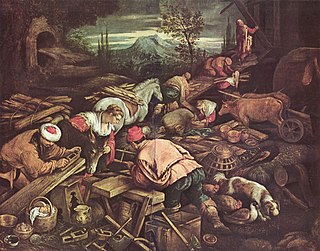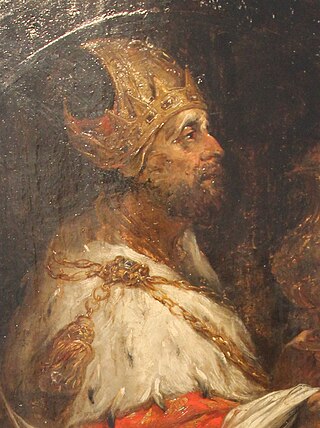
The Dead Sea Scrolls, also called the Qumran Caves Scrolls, are a set of ancient Jewish manuscripts from the Second Temple period. They were discovered over a period of 10 years, between 1946 and 1956, at the Qumran Caves near Ein Feshkha in the West Bank, on the northern shore of the Dead Sea. Dating from the 3rd century BCE to the 1st century CE, the Dead Sea Scrolls include the oldest surviving manuscripts of entire books later included in the biblical canons, along with extra-biblical and deuterocanonical manuscripts from late Second Temple Judaism. At the same time, they cast new light on the emergence of Christianity and of Rabbinic Judaism. Almost all of the 15,000 scrolls and scroll fragments are held in the Shrine of the Book at the Israel Museum, located in the city of Jerusalem. The Israeli government's custody of the Dead Sea Scrolls is disputed by Jordan and the Palestinian Authority on territorial, legal, and humanitarian grounds—they were mostly discovered following the Jordanian annexation of the West Bank and were acquired by Israel after Jordan lost the 1967 Arab–Israeli War—whilst Israel's claims are primarily based on historical and religious grounds, given their significance in Jewish history and in the heritage of Judaism.

Enoch is a biblical figure and patriarch prior to Noah's flood, and the son of Jared and father of Methuselah. He was of the Antediluvian period in the Hebrew Bible.

The Book of Jubilees, sometimes called Lesser Genesis or Leptogenesis, is an ancient Jewish apocryphal text of 50 chapters, considered canonical by the Ethiopian Orthodox Tewahedo Church as well as Beta Israel, where it is known as the Book of Division. Jubilees is considered one of the pseudepigrapha by the Eastern Orthodox, Catholic, and Protestant churches. Apart from the Beta Israel community, the book is not considered canonical within any of the denominations of Judaism.

The Book of Enoch is an ancient Hebrew apocalyptic religious text, ascribed by tradition to the patriarch Enoch who was the father of Methuselah and the great-grandfather of Noah. The Book of Enoch contains unique material on the origins of demons and Nephilim, why some angels fell from heaven, an explanation of why the Genesis flood was morally necessary, and a prophetic exposition of the thousand-year reign of the Messiah. Three books are traditionally attributed to Enoch, including the distinct works 2 Enoch and 3 Enoch.

The patriarchs of the Bible, when narrowly defined, are Abraham, his son Isaac, and Isaac's son Jacob, also named Israel, the ancestor of the Israelites. These three figures are referred to collectively as "the patriarchs", and the period in which they lived is known as the patriarchal age.
The genealogies of Genesis provide the framework around which the Book of Genesis is structured. Beginning with Adam, genealogical material in Genesis 4, 5, 10, 11, 22, 25, 29–30, 35–36, and 46 moves the narrative forward from the creation to the beginnings of the Israelites' existence as a people.

The Book of Giants is an apocryphal book which expands upon the Genesis narrative of the Hebrew Bible, in a similar manner to the Book of Enoch. Together with this latter work, the Book of Giants "stands as an attempt to explain how it was that wickedness had become so widespread and muscular before the flood; in so doing, it also supplies the reason why God was more than justified in sending that flood." The text's composition has been dated to before the 2nd century BC.

Joseph Augustine Fitzmyer was an American Catholic priest and scholar who taught at several American and British universities. He was a member of the Society of Jesus (Jesuits).

The wives aboard Noah's Ark were part of the family that survived the Deluge in the biblical Genesis flood narrative from the Bible. These wives are the wife of Noah, and the wives of each of his three sons. Although the Bible only notes the existence of these women, there are extra-biblical mentions regarding them and their names.

Józef Tadeusz Milik was a Polish biblical scholar and a Catholic priest, researcher of the Dead Sea Scrolls (DSS) through the deserts of Judea/Jordan, and translator and editor of the Book of Enoch in Aramaic (fragments).

In the Bible, Melchizedek, also transliterated Melchisedech or Malki Tzedek, was the king of Salem and priest of El Elyon. He is first mentioned in Genesis 14:18–20, where he brings out bread and wine and then blesses Abram and El Elyon.
The Book of Noah is thought to be a non-extant Old Testament pseudepigraphal work, attributed to Noah. It is quoted in several places in another pseudepigraphal work, 1 Enoch, and is mentioned in another, the Book of Jubilees. There have also been fragments attributed to a Book of Noah in the Dead Sea Scrolls.
Discoveries in the Judaean Desert (DJD) is the official 40-volume publication that serves as the editio princeps for the Dead Sea Scrolls. It is published by Oxford University Press.

4Q246, also known as the Son of God Text or the Aramaic Apocalypse, is one of the Dead Sea Scrolls found at Qumran which is notable for an early messianic mention of a son of God. The text is an Aramaic language fragment first acquired in 1958 from cave 4 at Qumran, and the major debate on this fragment has been on the identity of this "son of God" figure.
The Nahum Commentary or Pesher Nahum, labelled 4QpNah or 4Q169, was among the Dead Sea Scrolls in cave 4 of Qumran that was discovered in August 1952. The editio princeps of the text is to be found in DJD V., edited by John Allegro. The text is described thus: 'one of the "continuous pesharim" from Qumran, successive verses from the biblical Book of Nahum are interpreted as reflecting historical realities of the 1st century BCE."
In the Book of Enoch and Book of Jubilees, copies of which were kept by groups including the religious community of Qumran that produced the Dead Sea Scrolls, the Elioud are the antediluvian children of the Nephilim, and are considered a part-angel hybrid race of their own. Like the Nephilim, the Elioud are exceptional in both ability and wickedness.

The Testament of Qahat is a text found among the Dead Sea Scrolls.The manuscript has been dated on palaeographic grounds to 125-10 BCE, and the composition of this manuscript even earlier. It was written as a continuation to the Words of Levi, followed by the Visions of Amram.












